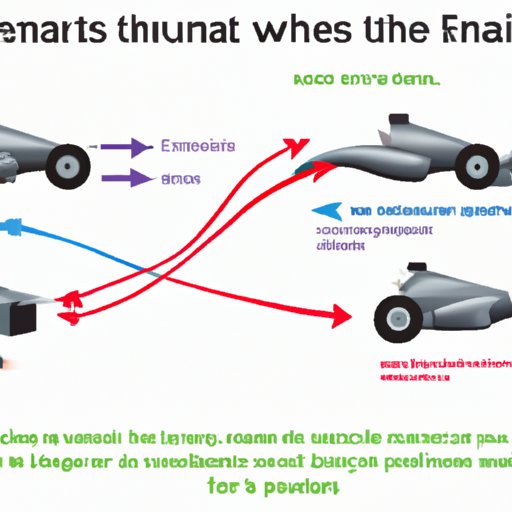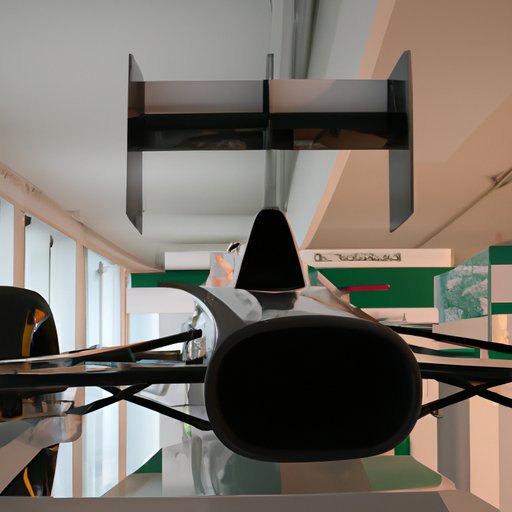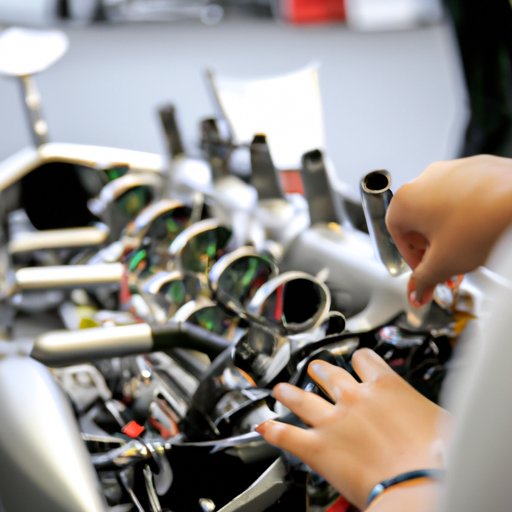Introduction
Formula One (F1) cars are some of the most advanced racing machines in the world. They are designed to achieve extreme levels of speed and maneuverability while still providing a safe experience for the driver. But how do these cars actually travel? In this article, we will explore the various aspects of F1 car travel, from the physics behind the forces that affect movement to the aerodynamic design and specialized materials used in construction. We will also examine the engine power and suspension system of F1 cars and their role in achieving high speeds.

The Physics of F1 Cars: Exploring How They Travel
In order to understand how F1 cars travel, it is important to first understand the physics behind the forces that affect movement. According to Newton’s laws of motion, a force applied to an object will cause it to accelerate or decelerate. This means that when a F1 car is driving, the forces acting on it can have an effect on its acceleration or deceleration.
The two main forces acting on a F1 car are drag and downforce. Drag is the resistance of the air against the car, which causes the car to slow down. There are three types of drag: pressure drag, induced drag, and viscous drag. Pressure drag is caused by the pressure of the air against the car, while induced drag is caused by the shape of the car and the turbulence created by its movement. Viscous drag is caused by friction between the air molecules and the surface of the car.
Downforce is the opposite of drag; it is the force that pushes the car down onto the track. This force is created by the shape of the car and the wings on the car, which help to create an area of low pressure underneath the car. This low pressure helps to suck the car down onto the track, allowing it to corner at higher speeds.

Exploring the Aerodynamics of F1 Cars and How They Move
Aerodynamics plays a major role in the performance of a F1 car. F1 cars are designed with aerodynamic features such as spoilers, diffusers, and wings. These features help to reduce drag and increase downforce, which in turn helps the car move faster and more efficiently.
The shape of the car is also important when it comes to aerodynamics. F1 cars are designed to be as aerodynamically efficient as possible, with a low, flat nose and curved sides to reduce drag. The wings on the car are also designed to reduce drag and increase downforce. The front wing is designed to direct the airflow around the car and create an area of low pressure underneath the car, while the rear wing helps to stabilize the car and reduce drag.
Different types of wings can be used to adjust the amount of downforce generated by the car. Splitters, fences, and Gurney flaps are all used to increase downforce, while drag reducing devices such as vortex generators and end plates are used to reduce drag. By adjusting the wings, the car can be optimized for different tracks and conditions.
Analyzing the Structure of F1 Cars and How They Achieve High Speeds
The structure of a F1 car is designed to be as light as possible yet strong enough to withstand the rigors of racing. F1 cars are made from lightweight materials such as carbon fiber, aluminum, and titanium, which help to keep the overall weight of the car down. This helps the car to achieve higher speeds and better fuel efficiency.
F1 cars also have a low center of gravity, which helps to improve handling and stability. This is achieved by lowering the engine and placing heavy components such as the battery and fuel tank as close to the ground as possible. This helps the car to corner more quickly and maintain control in high-speed corners.
Finally, F1 cars use specially designed tires to maximize grip and provide optimal performance. The tires are designed with special compounds that help to improve grip in wet and dry conditions, as well as tread patterns that help to disperse water. This helps the car to maintain maximum traction and corner at high speeds.

Examining the Engine Power of F1 Cars and How It Affects Performance
The engine of a F1 car is the heart of the machine and one of the most important aspects of its performance. F1 cars use powerful engines that are capable of producing up to 1,000 horsepower. This power is used to propel the car forward and help it achieve high speeds.
The power of a F1 engine is measured in terms of horsepower and torque. Horsepower is the amount of power an engine produces over time, while torque is the amount of turning force an engine produces. Both of these factors play a role in the performance of a F1 car.
The RPM (revolutions per minute) of the engine is also important when it comes to performance. Higher RPMs allow the engine to produce more power, which in turn allows the car to accelerate faster and reach higher speeds. The RPM of a F1 engine can reach up to 18,000 RPM, allowing the car to achieve amazing levels of performance.
Investigating the Suspension System of F1 Cars and Its Role in Movement
The suspension system of a F1 car is one of the most important aspects of its performance. The suspension system is responsible for absorbing the bumps and vibrations of the track, allowing the car to corner more quickly and maintain control at high speeds.
There are two types of suspension systems used in F1 cars: active and passive. Active suspension systems adjust the ride height of the car based on the conditions of the track, while passive suspension systems are fixed and cannot be adjusted.
The suspension system also includes shock absorbers, springs, and dampers. Shock absorbers absorb the bumps and vibrations of the track, while springs and dampers help to maintain the ride height of the car. All of these components can be adjusted to optimize the performance of the car for different tracks and conditions.
Conclusion
In conclusion, F1 cars are some of the most advanced racing machines in the world. They use a combination of physics, aerodynamics, lightweight materials, engine power, and suspension systems to achieve extreme levels of speed and maneuverability. By understanding the physics behind the forces that act on a F1 car, as well as the aerodynamic design, structure, engine power, and suspension system of a F1 car, we can gain a better understanding of how they travel.
(Note: Is this article not meeting your expectations? Do you have knowledge or insights to share? Unlock new opportunities and expand your reach by joining our authors team. Click Registration to join us and share your expertise with our readers.)
